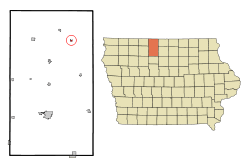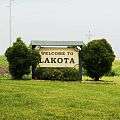Lakota, Iowa
Lakota is a city in Kossuth County, Iowa, United States. The population was 255 at the 2010 census. Prior to 1919, the town was known as Germania.[4]
Lakota, Iowa | |
|---|---|
 November sunset in Lakota, Iowa | |
 Location of Lakota, Iowa | |
| Coordinates: 43°22′41″N 94°5′39″W | |
| Country | |
| State | |
| County | Kossuth |
| Germania, Iowa | 1892 |
| Area | |
| • Total | 0.73 sq mi (1.88 km2) |
| • Land | 0.73 sq mi (1.88 km2) |
| • Water | 0.00 sq mi (0.00 km2) |
| Elevation | 1,142 ft (348 m) |
| Population | |
| • Total | 255 |
| • Estimate (2019)[3] | 279 |
| • Density | 383.24/sq mi (148.02/km2) |
| Time zone | UTC-6 (Central (CST)) |
| • Summer (DST) | UTC-5 (CDT) |
| ZIP code | 50451 |
| Area code(s) | 515 |
| FIPS code | 19-42825 |
| GNIS feature ID | 0458207 |
History
The present town of Lakota was originally named Germania. The original town site of Germania was surveyed and filed for record by the Northern Iowa Land and Town Lot Company, August 26, 1892.[5] The town received its name from the German heritage of many of the early settlers in the area. In 1918, the hysteria of World War I was sweeping the country. Residents couldn't change their origin to protect themselves from the popular hatred of the time, but they could take the stigma of all things German from the town by wiping its name off the map, which they did. An election was held on October 1, 1918 to vote to change the name of Germania, Iowa to Lakota, Iowa. A canvas of the votes showed there were 48 yes and 32 no votes cast. Mayor J. Gus Thaves filed the certificate changing the name to Lakota at the Kossuth County Courthouse on October 16, 1918. However the name was not officially changed by the post office until August 5, 1919. The town was renamed Lakota, an Indian word with several different translations. Some say Lakota means "beautiful prairie" or as other translations say Lakota means "plenty", others say it means "allies".[6]
Geography
Lakota is located at 43°22′41″N 94°5′39″W (43.377953, -94.094274).[7]
According to the United States Census Bureau, the city has a total area of 0.19 square miles (0.49 km2), all land.[8]
Demographics
| Year | Pop. | ±% |
|---|---|---|
| 1900 | 384 | — |
| 1910 | 436 | +13.5% |
| 1920 | 472 | +8.3% |
| 1930 | 409 | −13.3% |
| 1940 | 457 | +11.7% |
| 1950 | 443 | −3.1% |
| 1960 | 459 | +3.6% |
| 1970 | 385 | −16.1% |
| 1980 | 330 | −14.3% |
| 1990 | 281 | −14.8% |
| 2000 | 255 | −9.3% |
| 2010 | 255 | +0.0% |
| 2019 | 279 | +9.4% |
| Source:"U.S. Census website". United States Census Bureau. Retrieved 2020-03-29. and Iowa Data Center Source: | ||
2010 census
As of the census[2] of 2010, there were 255 people, 119 households, and 71 families living in the city. The population density was 1,342.1 inhabitants per square mile (518.2/km2). There were 136 housing units at an average density of 715.8 per square mile (276.4/km2). The racial makeup of the city was 94.1% White, 0.8% Native American, 3.9% from other races, and 1.2% from two or more races. Hispanic or Latino of any race were 5.9% of the population.
There were 119 households, of which 18.5% had children under the age of 18 living with them, 47.1% were married couples living together, 7.6% had a female householder with no husband present, 5.0% had a male householder with no wife present, and 40.3% were non-families. 37.0% of all households were made up of individuals, and 15.1% had someone living alone who was 65 years of age or older. The average household size was 2.14 and the average family size was 2.72.
The median age in the city was 48.4 years. 19.6% of residents were under the age of 18; 9.4% were between the ages of 18 and 24; 15.6% were from 25 to 44; 31% were from 45 to 64; and 24.3% were 65 years of age or older. The gender makeup of the city was 51.4% male and 48.6% female.
2000 census
As of the census[10] of 2000, there were 255 people, 118 households, and 71 families living in the city. The population density was 1,334.7 people per square mile (518.2/km2). There were 141 housing units at an average density of 738.0 per square mile (286.5/km2). The racial makeup of the city was 98.43% White, 0.39% from other races, and 1.18% from two or more races. Hispanic or Latino of any race were 3.53% of the population.
There were 118 households, out of which 25.4% had children under the age of 18 living with them, 52.5% were married couples living together, 6.8% had a female householder with no husband present, and 39.8% were non-families. 38.1% of all households were made up of individuals, and 22.9% had someone living alone who was 65 years of age or older. The average household size was 2.16 and the average family size was 2.85.
In the city, the population was spread out, with 24.3% under the age of 18, 6.7% from 18 to 24, 23.5% from 25 to 44, 21.2% from 45 to 64, and 24.3% who were 65 years of age or older. The median age was 41 years. For every 100 females, there were 88.9 males. For every 100 females age 18 and over, there were 94.9 males.
The median income for a household in the city was $27,917, and the median income for a family was $43,500. Males had a median income of $30,357 versus $18,750 for females. The per capita income for the city was $18,572. About 14.7% of families and 19.4% of the population were below the poverty line, including 23.1% of those under the age of eighteen and 28.1% of those 65 or over.
Education
It is within the North Iowa Community School District,[11] which was established on July 1, 1996 by the merger of the Buffalo Center-Rake-Lakota Community School District and the Thompson Community School District. On July 1, 1992, the Lakota Community School District merged with the Buffalo Center-Rake Community School District to form the Buffalo Center-Rake-Lakota district, and that district merged into North Iowa in 1996.[12]
Notable people
- Don I. Wortman, federal government executive
- Paul Ukena, opera singer.[13]
- Timothy Ley, hematologist and cancer biologist
Gallery
 City of Lakota Welcome Sign purchased/installed by the Lakota Community Club.
City of Lakota Welcome Sign purchased/installed by the Lakota Community Club. City flag pole garden located in Lakota City Park
City flag pole garden located in Lakota City Park Water tower in Lakota, Iowa
Water tower in Lakota, Iowa Eagle Center, Lakota, Iowa
Eagle Center, Lakota, Iowa Veterans Memorial
Veterans Memorial
References
- "2019 U.S. Gazetteer Files". United States Census Bureau. Retrieved July 17, 2020.
- "U.S. Census website". United States Census Bureau. Retrieved 2012-05-11.
- "Population and Housing Unit Estimates". United States Census Bureau. May 24, 2020. Retrieved May 27, 2020.
- William C Hunt (1921). Fourteenth census of the United States taken in the year 1920. Government Publishing Office. p. 214. Retrieved 24 July 2011.
germania lakota.
- Reed, Benjamin F. (1913). History of Kossuth County, Iowa, Volume 1. S. J. Clarke Publishing Company. p. 697.
- http://www.kossuthcountygenealogicalsociety.com/Local/places.htm
- "US Gazetteer files: 2010, 2000, and 1990". United States Census Bureau. 2011-02-12. Retrieved 2011-04-23.
- "US Gazetteer files 2010". United States Census Bureau. Archived from the original on 2012-07-02. Retrieved 2012-05-11.
- "Census of Population and Housing". Census.gov. Retrieved June 4, 2015.
- "U.S. Census website". United States Census Bureau. Retrieved 2008-01-31.
- "North Iowa" (PDF). Iowa Department of Education. Retrieved 2019-08-02.
- "REORGANIZATION & DISSOLUTION ACTIONS SINCE 1965-66" (PDF). Iowa Department of Education. Archived from the original (PDF) on 2019-02-09. Retrieved 2019-08-01.
- Paul Ukena, 69, A Former Baritone With City Opera